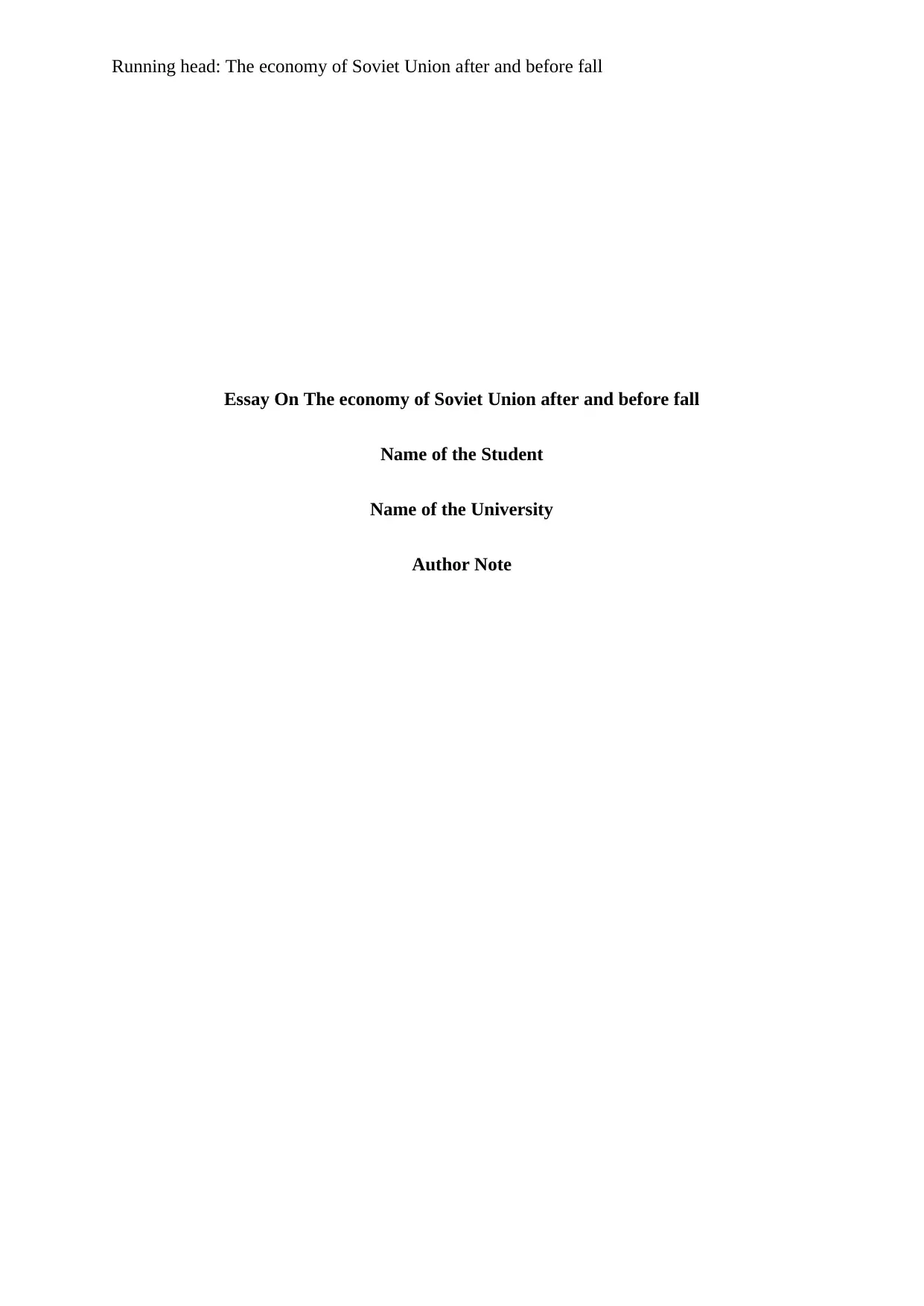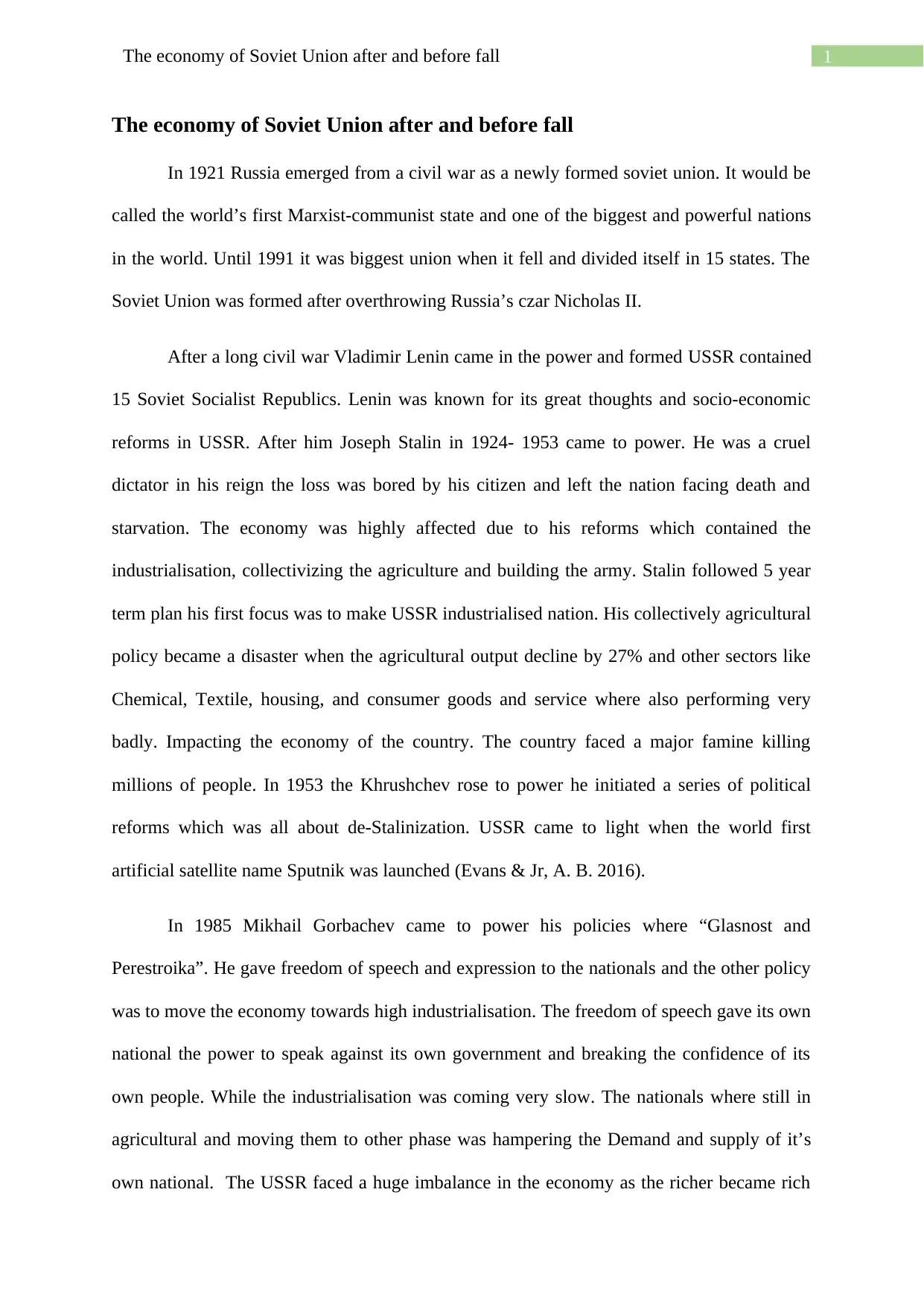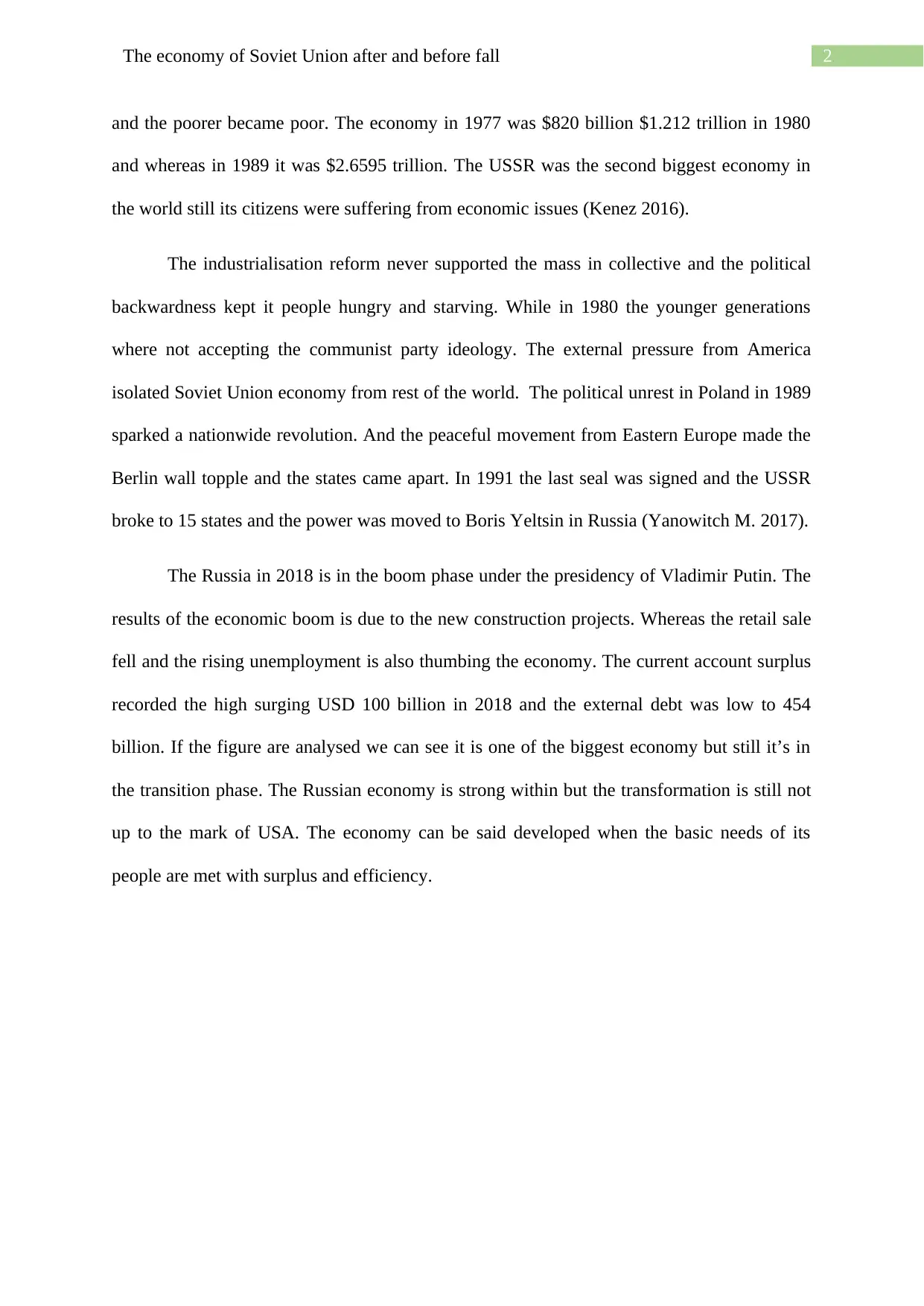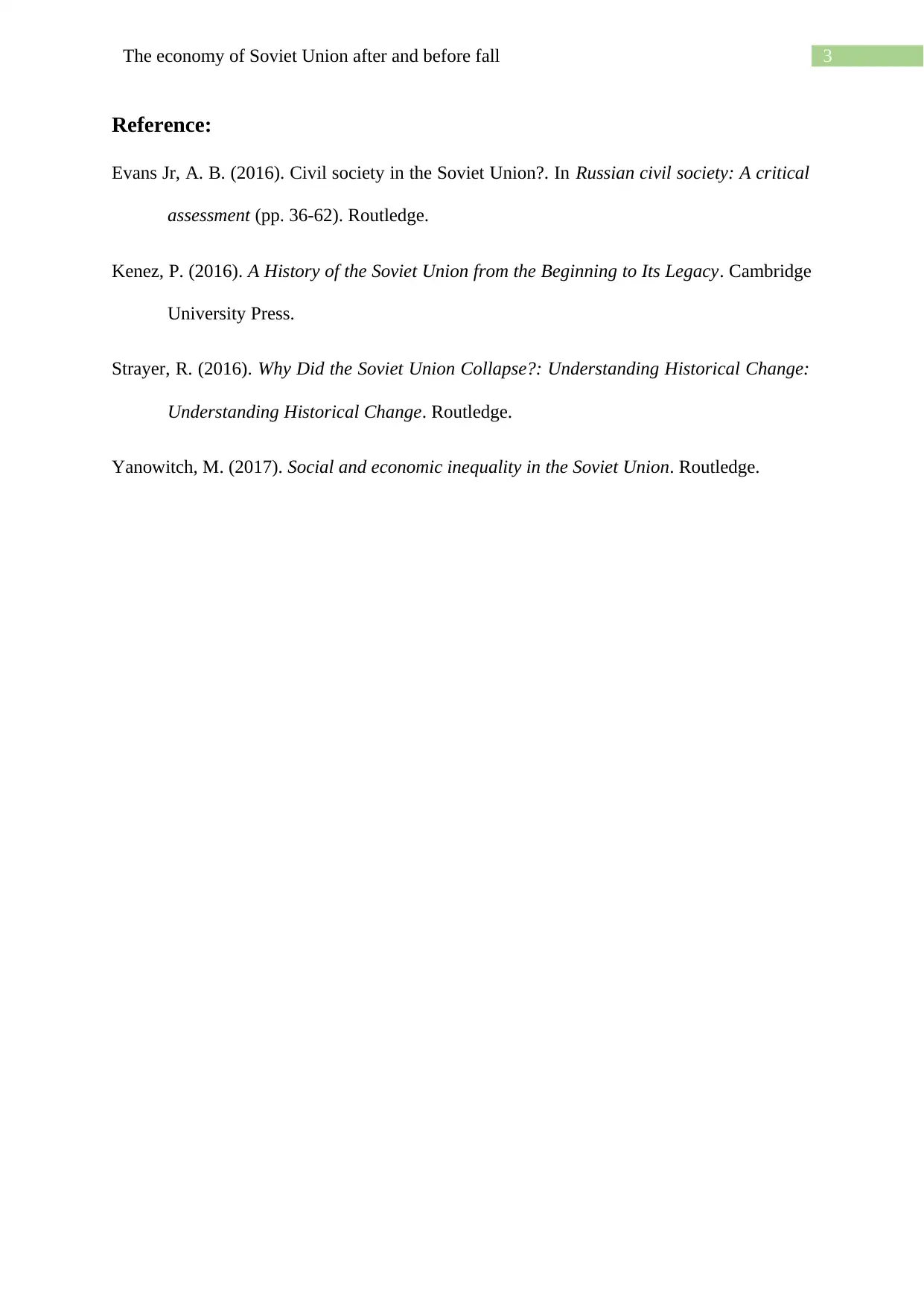Soviet Union's Economy: A Historical Analysis Pre and Post Fall
VerifiedAdded on 2023/04/21
|4
|854
|439
Essay
AI Summary
This essay examines the economy of the Soviet Union from its inception in 1921 to its dissolution in 1991, and its subsequent transition. It discusses Lenin's socio-economic reforms, Stalin's industrialization and collectivization policies which led to famine and economic decline, Khrushchev's de-Stalinization, and Gorbachev's Glasnost and Perestroika. The essay highlights the economic imbalances, political unrest, and external pressures that contributed to the USSR's collapse. It also touches upon Russia's economic state in 2018 under Vladimir Putin, noting both its strengths and ongoing challenges in achieving a fully developed economy. Desklib offers a wealth of similar essays and study resources for students.

Running head: The economy of Soviet Union after and before fall
Essay On The economy of Soviet Union after and before fall
Name of the Student
Name of the University
Author Note
Essay On The economy of Soviet Union after and before fall
Name of the Student
Name of the University
Author Note
Paraphrase This Document
Need a fresh take? Get an instant paraphrase of this document with our AI Paraphraser

1The economy of Soviet Union after and before fall
The economy of Soviet Union after and before fall
In 1921 Russia emerged from a civil war as a newly formed soviet union. It would be
called the world’s first Marxist-communist state and one of the biggest and powerful nations
in the world. Until 1991 it was biggest union when it fell and divided itself in 15 states. The
Soviet Union was formed after overthrowing Russia’s czar Nicholas II.
After a long civil war Vladimir Lenin came in the power and formed USSR contained
15 Soviet Socialist Republics. Lenin was known for its great thoughts and socio-economic
reforms in USSR. After him Joseph Stalin in 1924- 1953 came to power. He was a cruel
dictator in his reign the loss was bored by his citizen and left the nation facing death and
starvation. The economy was highly affected due to his reforms which contained the
industrialisation, collectivizing the agriculture and building the army. Stalin followed 5 year
term plan his first focus was to make USSR industrialised nation. His collectively agricultural
policy became a disaster when the agricultural output decline by 27% and other sectors like
Chemical, Textile, housing, and consumer goods and service where also performing very
badly. Impacting the economy of the country. The country faced a major famine killing
millions of people. In 1953 the Khrushchev rose to power he initiated a series of political
reforms which was all about de-Stalinization. USSR came to light when the world first
artificial satellite name Sputnik was launched (Evans & Jr, A. B. 2016).
In 1985 Mikhail Gorbachev came to power his policies where “Glasnost and
Perestroika”. He gave freedom of speech and expression to the nationals and the other policy
was to move the economy towards high industrialisation. The freedom of speech gave its own
national the power to speak against its own government and breaking the confidence of its
own people. While the industrialisation was coming very slow. The nationals where still in
agricultural and moving them to other phase was hampering the Demand and supply of it’s
own national. The USSR faced a huge imbalance in the economy as the richer became rich
The economy of Soviet Union after and before fall
In 1921 Russia emerged from a civil war as a newly formed soviet union. It would be
called the world’s first Marxist-communist state and one of the biggest and powerful nations
in the world. Until 1991 it was biggest union when it fell and divided itself in 15 states. The
Soviet Union was formed after overthrowing Russia’s czar Nicholas II.
After a long civil war Vladimir Lenin came in the power and formed USSR contained
15 Soviet Socialist Republics. Lenin was known for its great thoughts and socio-economic
reforms in USSR. After him Joseph Stalin in 1924- 1953 came to power. He was a cruel
dictator in his reign the loss was bored by his citizen and left the nation facing death and
starvation. The economy was highly affected due to his reforms which contained the
industrialisation, collectivizing the agriculture and building the army. Stalin followed 5 year
term plan his first focus was to make USSR industrialised nation. His collectively agricultural
policy became a disaster when the agricultural output decline by 27% and other sectors like
Chemical, Textile, housing, and consumer goods and service where also performing very
badly. Impacting the economy of the country. The country faced a major famine killing
millions of people. In 1953 the Khrushchev rose to power he initiated a series of political
reforms which was all about de-Stalinization. USSR came to light when the world first
artificial satellite name Sputnik was launched (Evans & Jr, A. B. 2016).
In 1985 Mikhail Gorbachev came to power his policies where “Glasnost and
Perestroika”. He gave freedom of speech and expression to the nationals and the other policy
was to move the economy towards high industrialisation. The freedom of speech gave its own
national the power to speak against its own government and breaking the confidence of its
own people. While the industrialisation was coming very slow. The nationals where still in
agricultural and moving them to other phase was hampering the Demand and supply of it’s
own national. The USSR faced a huge imbalance in the economy as the richer became rich

2The economy of Soviet Union after and before fall
and the poorer became poor. The economy in 1977 was $820 billion $1.212 trillion in 1980
and whereas in 1989 it was $2.6595 trillion. The USSR was the second biggest economy in
the world still its citizens were suffering from economic issues (Kenez 2016).
The industrialisation reform never supported the mass in collective and the political
backwardness kept it people hungry and starving. While in 1980 the younger generations
where not accepting the communist party ideology. The external pressure from America
isolated Soviet Union economy from rest of the world. The political unrest in Poland in 1989
sparked a nationwide revolution. And the peaceful movement from Eastern Europe made the
Berlin wall topple and the states came apart. In 1991 the last seal was signed and the USSR
broke to 15 states and the power was moved to Boris Yeltsin in Russia (Yanowitch M. 2017).
The Russia in 2018 is in the boom phase under the presidency of Vladimir Putin. The
results of the economic boom is due to the new construction projects. Whereas the retail sale
fell and the rising unemployment is also thumbing the economy. The current account surplus
recorded the high surging USD 100 billion in 2018 and the external debt was low to 454
billion. If the figure are analysed we can see it is one of the biggest economy but still it’s in
the transition phase. The Russian economy is strong within but the transformation is still not
up to the mark of USA. The economy can be said developed when the basic needs of its
people are met with surplus and efficiency.
and the poorer became poor. The economy in 1977 was $820 billion $1.212 trillion in 1980
and whereas in 1989 it was $2.6595 trillion. The USSR was the second biggest economy in
the world still its citizens were suffering from economic issues (Kenez 2016).
The industrialisation reform never supported the mass in collective and the political
backwardness kept it people hungry and starving. While in 1980 the younger generations
where not accepting the communist party ideology. The external pressure from America
isolated Soviet Union economy from rest of the world. The political unrest in Poland in 1989
sparked a nationwide revolution. And the peaceful movement from Eastern Europe made the
Berlin wall topple and the states came apart. In 1991 the last seal was signed and the USSR
broke to 15 states and the power was moved to Boris Yeltsin in Russia (Yanowitch M. 2017).
The Russia in 2018 is in the boom phase under the presidency of Vladimir Putin. The
results of the economic boom is due to the new construction projects. Whereas the retail sale
fell and the rising unemployment is also thumbing the economy. The current account surplus
recorded the high surging USD 100 billion in 2018 and the external debt was low to 454
billion. If the figure are analysed we can see it is one of the biggest economy but still it’s in
the transition phase. The Russian economy is strong within but the transformation is still not
up to the mark of USA. The economy can be said developed when the basic needs of its
people are met with surplus and efficiency.
⊘ This is a preview!⊘
Do you want full access?
Subscribe today to unlock all pages.

Trusted by 1+ million students worldwide

3The economy of Soviet Union after and before fall
Reference:
Evans Jr, A. B. (2016). Civil society in the Soviet Union?. In Russian civil society: A critical
assessment (pp. 36-62). Routledge.
Kenez, P. (2016). A History of the Soviet Union from the Beginning to Its Legacy. Cambridge
University Press.
Strayer, R. (2016). Why Did the Soviet Union Collapse?: Understanding Historical Change:
Understanding Historical Change. Routledge.
Yanowitch, M. (2017). Social and economic inequality in the Soviet Union. Routledge.
Reference:
Evans Jr, A. B. (2016). Civil society in the Soviet Union?. In Russian civil society: A critical
assessment (pp. 36-62). Routledge.
Kenez, P. (2016). A History of the Soviet Union from the Beginning to Its Legacy. Cambridge
University Press.
Strayer, R. (2016). Why Did the Soviet Union Collapse?: Understanding Historical Change:
Understanding Historical Change. Routledge.
Yanowitch, M. (2017). Social and economic inequality in the Soviet Union. Routledge.
1 out of 4
Related Documents
Your All-in-One AI-Powered Toolkit for Academic Success.
+13062052269
info@desklib.com
Available 24*7 on WhatsApp / Email
![[object Object]](/_next/static/media/star-bottom.7253800d.svg)
Unlock your academic potential
Copyright © 2020–2025 A2Z Services. All Rights Reserved. Developed and managed by ZUCOL.





